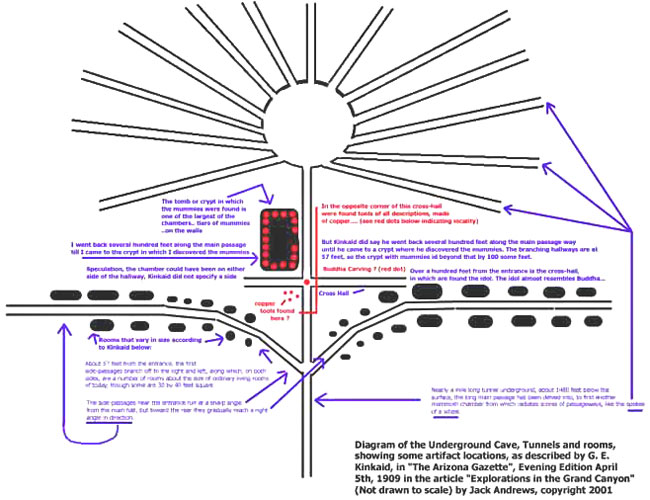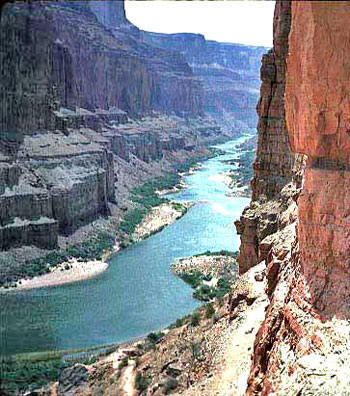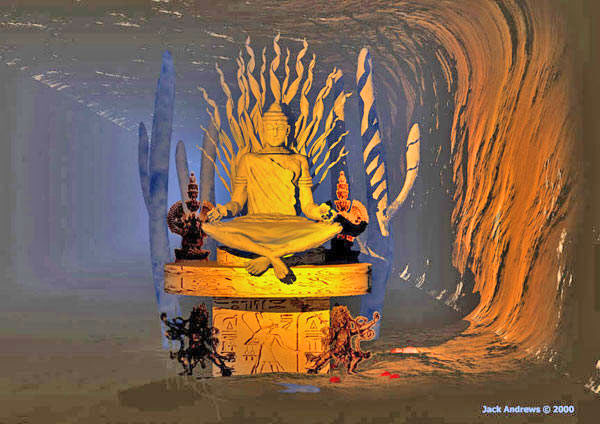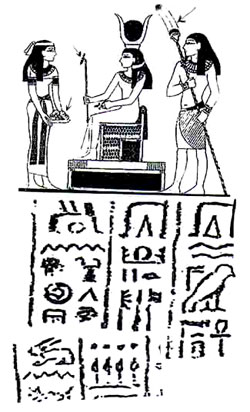"The latest news of the progress of
the explorations of what is now regarded by scientists as not
only the oldest archaeological discovery in the United States,
but one of the most valuable in the world, which was mentioned
some time ago in the Gazette, was brought to the city by G.E.
Kinkaid, the explorer who found this great underground
citadel of the Grand Canyon during a trip from Green River,
Wyoming, down the Colorado river, in a wooden boat, to Yuma,
several months ago.
According to
the story related to the Gazette, the
archaeologists of the Smithsonian Institute, which is financing
the explorations, have made discoveries which almost
conclusively prove that the race which inhabited this mysterious
cavern, hewn in solid rock by human hands, was of oriental
origin, possibly from Egypt,
tracing back to Rameses.
If
their theories are born out by the translation of the tablets
engraved with hieroglyphics, the mystery of the prehistoric
peoples of North America, their ancient arts, who they were and
whence they came, will be solved. Egypt and the Nile, and
Arizona and the Colorado will be linked by a historical
chain running back to ages which stagger
the wildest fancy of
the fictionist.
"Under the direction of Professor
S. A. Jordan, the
Smithsonian is now pursuing the most thorough explorations,
which will be continued until the last link in the chain is
forged.
Nearly a mile underground, about 1480 feet below the
surface, the long main passage has been delved into, to find
another mammoth chamber from which radiates scores of
passageways, like the spokes of a wheel.

Several hundred rooms
have been discovered, reached by passageways running from the
main passage, one of them having been explored for 854 feet and
another 634 feet.
The recent finds include articles, which have
never been known as native to this country and that doubtless
they had their origin in the orient.
War weapons, copper
instruments, sharp edged and hard as steel, indicate the high
state of civilization reached by these strange people. So
interested have the scientists become that preparations are
being made to equip the camp for extensive studies, and the
force will be increased to thirty or forty persons.
"Before going further into the cavern, better facilities for
lighting will have to be installed, for the darkness is dense
and quite impenetrable for the average flashlight. In order to
avoid being lost, wires are being strung from the entrance to
all passageways leading directly to large chambers.
How far this
cavern extends no one can guess, but it is now the belief of
many that what has already been explored is merely the
‘barracks’, to use an American term, for the soldiers, and that
further into the underworld will be found the main communal
dwellings of the families. The perfect ventilation of the
cavern, the steady draught that blows through, indicates that it
has another outlet to the surface.
"Kinkaid was the first white man born in Idaho and has been an
explorer and hunter all his life, thirty years having been in
the service of the Smithsonian. Even briefly recounted, his
history sounds fabulous, almost grotesque.
‘First, I would impress that the cavern is nearly
inaccessible.
The entrance is 1,486 feet down the sheer
canyon wall. It is located on government land and no visitor
will be allowed there under penalty of trespass. The scientists
wish to work unmolested, without fear of the archaeological
discoveries being disturbed by curio or relic hunters.

Marble Canyon, Grand
Canyon National Park Arizona
A trip there would be fruitless, and
the visitor would be sent on his way.
The story of how I found
the cavern has been related, but in a paragraph: I was
journeying down the Colorado River in a boat, alone, looking for
mineral. Some forty-two miles up the river from the El Tovar
Crystal canyon, I saw on the east wall, stains in the
sedimentary formation about 2,000 feet above the river bed.
There was no trail to this point, but I finally reached it with
great difficulty. Above a shelf that hid it from view from the
river, was the mouth of the cave.
There are steps leading from
this entrance some thirty yards to what was, at the time the
cavern was inhabited, the level of the river. When I saw the
chisel marks on the wall inside the entrance, I become
interested, securing my gun and went in. During that trip I went
back several hundred feet along the main passage, until I came
to the crypt in which I discovered the mummies.
One of these I
stood up and photographed by flashlight. I gathered a number of
relics, which I carried down the Colorado to Yuma, from whence I
shipped them to Washington with details of the discovery.
Following this, the explorations were undertaken.’
"The main passageway is about 12 feet wide, narrowing to nine
feet toward the farther end. About 57 feet from the entrance,
the first side passages branch off to the right and left, along
which, on both sides, are a number of rooms about the size of
ordinary living rooms of today, though some are 30 by 40 feet
square.
These are entered by oval shaped doors and are
ventilated by round air spaces through the walls into the
passages. The walls are about three feet six inches in
thickness.
The passages are chiseled or hewn as straight as
could be laid out by an engineer. The ceilings of many of the
rooms converge to the center. The side-passages near the
entrance run at a sharp angle from the main hall, but toward the
rear they gradually reach a right angle in direction.
"Over a hundred feet from the entrance is the cross-hall,
several hundred feet long, in which are found the idol, or
image, of the people's god, sitting cross-legged, with a lotus
flower or lily in each hand. The cast of the face is oriental,
and the carving shows a skillful hand, and the attire is
remarkably well preserved, as is everything in this cavern.
The
idol most resembles Buddha, though the scientists are not
certain as to what religious worship it represents.

3D computer rendering by
Jack Andrews
Taking into consideration everything
found thus far, it is possible that this worship most resembles
the ancient people of Tibet.
Surrounding this idol are smaller
images, some very beautiful in form; others crooked-necked and
distorted shapes, symbolical, probably, of good and evil. There
are two large cactus with protruding arms, one on each side of
the dais on which the god squats.
All this is
carved out of hard
rock resembling marble.
In the opposite corner of this
cross-hall were found tools of all descriptions, made of copper.
These people undoubtedly knew the lost art of hardening this
metal, which has been sought by chemists for centuries without
result. On a bench running around the workroom was some charcoal
and other material probably used in the process. There is also
slag and stuff similar to metal, showing that these ancients
smelted ores, but so far no trace of where or how this was done
has been discovered, nor the origin of the ore.
"Among the other finds are vases or urns and cups of copper and
gold, made very artistic in design. The pottery work includes
enameled ware and glazed vessels. Another passageway leads to
granaries such as are found in the oriental temples.
They
contain seeds of various kinds. One very large storehouse has
not yet been entered, as it is twelve feet high and can be
reached only from above. Two copper hooks extend on the edge,
which indicates that some sort of ladder was attached.
These
granaries are rounded, as the materials, of which they are
constructed, I think, is very hard cement. A gray metal is also
found in this cavern, which puzzles the scientists, however its
identity has not been established. It resembles platinum. Strewn
promiscuously over the floor everywhere is what people call
'cats eyes,' a yellow stone of no great value. Each one is
engraved with the head of the Malay type.
"On all the urns, or walls over doorways, and tablets of stone
which were found by the image are the mysterious hieroglyphics,
the key to which the Smithsonian Institute hopes yet to
discover. The engraving on the tablets probably has something to
do with the religion of the people. Similar hieroglyphics have
been found in southern Arizona.
Among the pictorial writings,
only two animals are found.
One is of prehistoric type.

Above is a scan of a tracing
of a xerox copy of photograph(s)? depicting hieroglyphics
allegedly photographed by G.
E. Kincaid in 1908 inside the cave in the Grand Canyon.
This was submitted to me from
a friend with a request that
the source remain anonymous,
a request I always honor.
-
Jack Andrews
"The tomb or crypt in which the
mummies were found is one of the largest of the chambers, the
walls slanting back at an angle of about 35 degrees. One of
these is tiers of mummies, each one occupying a separate hewn
shelf. At the head of each is a small bench, on which are found
copper cups and pieces of broken swords.
Some of the mummies are
covered with clay, and all are wrapped in a bark fabric. The
urns or cups on the lower tiers are crude, while as the higher
shelves are reached the urns are finer in design, showing a
later stage of civilization. It is worthy of note that all the
mummies examined so far have proved to be male, no children or
females being buried here. This leads to the belief that this
exterior section was the warriors' barracks.


3D computer rendering by
Jack Andrews
"Among the discoveries no bones of
animals have been found, no skins, no clothing or bedding.
Many
of the rooms are bare but for water vessels. One room, about 40
by 700 feet, was probably the main dining hall, for cooking
utensils are found here. What these people lived on is a
problem, though it is presumed that they came south in the
winter and farmed in the valleys, going back north in the
summer. Upwards of 50,000 people could have lived in the caverns
comfortably.
One theory is that the present Indian tribes found
in Arizona are descendants of the serfs or slaves of the people
that inhabited the cave. Undoubtedly a good many thousands of
years before the Christian era a people lived here which reached
a high stage of civilization. The chronology of human history is
full of gaps. Professor Jordan is much enthused over the
discoveries and believes that the find will prove of
incalculable value in archaeological work
"One thing I have not spoken of, may be of interest. There is
one chamber the passageway to which is not ventilated, and when
we approached it a deadly, snaky smell struck us. Our lights
would not penetrate the gloom, and until stronger ones are
available we will not know what the chamber contains. Some say
snakes, but others boohoo this idea and think it may contain a
deadly gas or chemicals used by the ancients. No sounds are
heard, but it smells snaky just the same.
The whole underground
installation gives one of shaky nerves the creeps. The gloom is
like a weight on one's shoulders, and our flashlights and
candles only make the darkness blacker. Imagination can revel in
conjectures and ungodly daydreams back through the ages that
have elapsed till the mind reels dizzily in space.
"In connection with this story, it is notable that among the
Hopi Indians the tradition is
told that their ancestors once
lived in an underworld in the
Grand Canyon till dissension arose between the good and the
bad, the people of one heart and the people of two hearts. Machetto, who was their chief, counseled them to leave the
underworld, but there was no way out.
The chief then caused a
tree to grow up and pierce the roof of the underworld, and then
the people of one heart climbed out. They tarried by Paisisvai (Red River), which is the Colorado, and grew grain
and corn. They sent out a message to the Temple of the Sun,
asking the blessing of peace, good will and rain hr the people
of one heart. That messenger never returned, but today at the
Hopi villages at sundown can be seen the old men of the
tribe out on the housetops gazing toward the sun, looking hr the
messenger.
When he returns, their lands and ancient dwelling
place will be restored to them. That is the tradition. Among the
engravings of animals in the cave is seen the image of a heart
over the spot where it is located. The legend was learned by W.E. Rollins, the artist, during a year spent with the Hopi
Indians. There are two theories of the origin of the
Egyptians.
One is that they came from Asia; another that the
racial cradle was in the upper Nile region. Heeren, an
Egyptologist, believed in the Indian origin of the Egyptians.
The discoveries in the Grand Canyon may throw further light on
human evolution and prehistoric ages."






